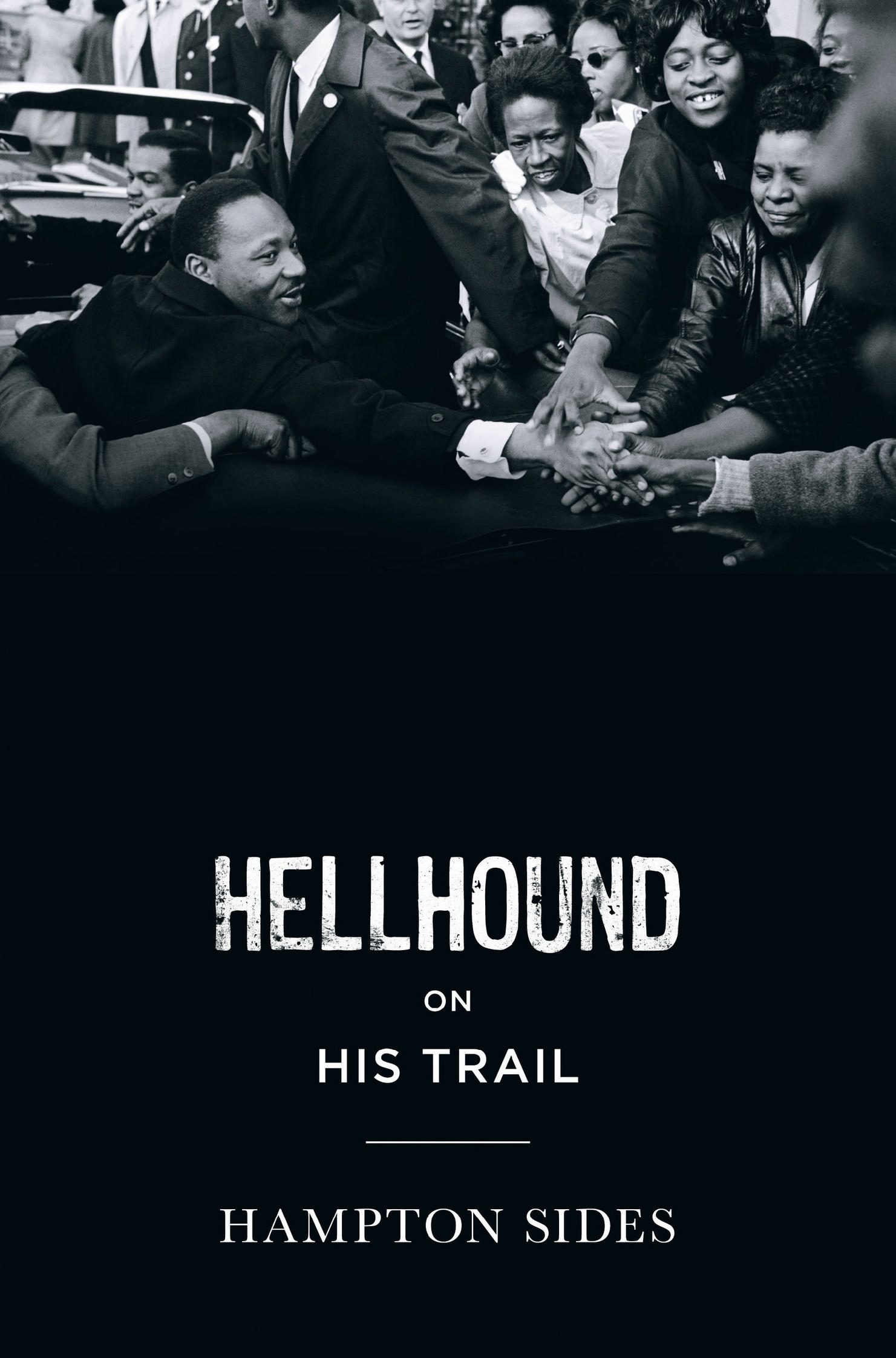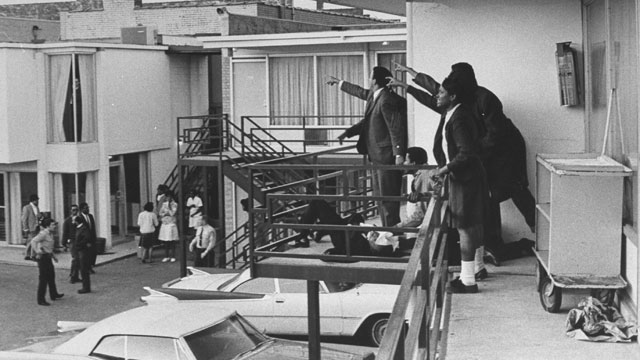
A Book Review from the Los Angeles Times, "‘Hellhound on His Trail’ by Hampton Sides: A bestselling author reconstructs an assassin’s life and the events leading up to the killing of the Rev. Martin Luther King Jr.," by Art Winslow, on 25 April 2010 -- Told that his activities were "unwise and untimely," the Rev. Martin Luther King Jr. responded, in his famous 1963 "Letter From Birmingham Jail," that while he was committed to nonviolence, "I am in Birmingham because injustice is here." Five years later, he was in Memphis, Tenn., for similar reasons — to demonstrate in support of 1,300 city sanitation workers who were on strike — when he was gunned down on a motel balcony, waiting to go to dinner. He was in high spirits, for his associates from the Southern Christian Leadership Conference had that very day won a court battle allowing King to lead a march in the city.
James Earl Ray, the dodgy career criminal and escaped convict who murdered King and helped turn 1968 into the sad, tumultuous year that it was, is the man with the gun in Hampton Sides' "Hellhound on His Trail: The Stalking of Martin Luther King Jr. and the International Hunt for His Assassin." And yet there are hellhounds aplenty in Sides' book, notable among them George Wallace, J. Edgar Hoover and J.B. Stoner, chair of the National States' Rights Party and publisher of hate literature, who contended that Ray "should be given the Congressional Medal of Honor." (Stoner eventually became one in Ray's long line of attorneys and was the first of them to suggest that "agents of the federal government," not Ray, killed King.)

Hellhound on His Trail: The Stalking of Martin Luther King Jr. and the International Hunt for His Assassin, By Hampton Sides
Wallace, the former governor of Alabama, was running a segregationist-minded, third-party campaign for president and found a supporter and volunteer in Ray (Wallace referred to civil-rights legislation as "an assassin's knife stuck in the back of liberty," a view he disowned years later). Hoover, director of the FBI, had nursed a vendetta against King for a decade, called the civil-rights leader "Burrhead" and other names and fretted privately to President Lyndon Johnson that it was "clear [King] is an instrument in the hands of subversive forces seeking to undermine our nation."
Sides has managed to frame a grim cutout of the 1960s within a few weeks of springtime 1968 by following the paths of King and Ray in a deadly pas de deux. We are reminded of the other momentous political events fitting within this tight time frame: LBJ's game-changing announcement that he would not run for reelection (March 31) occurred a handful of days before King was assassinated (April 4), and Sen. Robert F. Kennedy was shot on the presidential campaign trail (June 5) as authorities were closing in on Ray. After nine weeks on the run, King's murderer was seized in London on the day of RFK's funeral service in New York (June 8).

One challenge for Sides is that King's trajectory is among the most well-charted of any modern political figure (David Garrow's "Bearing the Cross" and the third volume of Taylor Branch's King biography, "At Canaan's Edge," for the last years, are good examples), and an exacting look at Ray's criminal past, the assassination, his guilty plea, imprisonment and the evidence can be found in Gerald Posner's "Killing the Dream," published a dozen years ago. As Sides' source notes make clear, he has surveyed the enormous range of available literature (including memoirs of on-the-scene principals such as Andrew Young, an SCLC staffer in 1968, and Ralph Abernathy, the longtime trusted colleague who succeeded King as head of the leadership conference), examined FBI files, oral histories and other archival documentation, and expended the journalistic shoe leather to go back and reinterview multiple witnesses and participants in the hunt for the killer (including then-U.S. Atty. Gen. Ramsey Clark).
The result is a taut, vibrant account that shows the synchronicity of movements as King and his colleagues plot political strategy and follow his speaking itinerary, while Ray draws ever closer in what would seem an erratic path if we didn't know, as in myth, that a tragedy foreordained lay on the road ahead.
Sides' writing is trenchant on King's political aims and concerns, stuffed with sharp first-person quotations, chilling in detail and particularly haunting in evoking the confusion and pathos in the minutes following the single crack of Ray's rifle. Half of "Hellhound on His Trail" builds up to the murder, the remaining half follows law-enforcement attempts to identify and track down the unknown assailant, and the efforts by King's bereft circle to carry on his work in earnest.

On the night of King's death, a curfew was instituted in Memphis and the National Guard was called in (eventually numbering 4,000 guardsmen) with its helicopters and half-tracks. The city "for all intents and purposes, was girding for war," Sides writes, a reflex if nothing else in a nation jittery from riots in Watts, Detroit, Newark, N.J., and elsewhere from 1965 on. Callers to a popular white radio station — one of the shameful but telling details studded throughout the book — repeatedly requested that "Bye Bye Blackbird" be played. When the FBI office in Atlanta (where King was code-named "Zorro") received the news of King's death, an agent named James Rose "nearly jumped up and down with joy," exclaiming, "They got Zorro." Fires were set in Washington and other cities, and a day later LBJ went on national television (for a second time) to make a brief statement, pleading that violence "must be denied its victory."
When King's widow, Coretta, arrived at the Memphis airport to claim his body, aboard a plane that had been provided by RFK, not a single official from the city of Memphis — not Mayor Henry Loeb III, not the director of police, nor any city councilman — showed up to greet her. She refused to leave the plane. On April 9, the day of King's funeral in his home city of Atlanta, most flags were at half-staff, "but some flew upside-down, sending a message not of sorrow but of bitterness and defiance."
In his final weeks, King had been stumping for a new plan: launching a Poor People's Campaign in which an army of the impoverished would occupy a tent city on the National Mall in Washington. The Memphis strike represented "the Washington campaign in miniature," he told his staff. To King, the entire nonviolent approach was on the line — a previous march in Memphis had gone awry, turning violent with hurled bottles and bricks and even looting, deeply embarrassing King, who felt the need to show it was an aberration.

King never got his chance, thanks to the man who called himself by a variety of names, among them Eric Galt and Ramon Sneyd, aliases that Sides uses in his narration. Galt/Sneyd/Ray dressed in a suit but stayed in flophouses, drove a white Mustang (his getaway vehicle), frequented whorehouses and came from a family of fellow felons. One or another of his brothers may have given him aid, the likely limits of a conspiracy if there was one. That, at least, is the implication of the House Select Committee on Assassinations' 1979 report and the conclusion reached by Posner in "Killing the Dream."
Sides is skeptical but not definitive on the conspiracy question, simply pointing to the views of others. Like them, though, he is struck by lingering questions about Ray's precise motivation — unanswerable, since Ray died in prison in 1998. What we do know is what the Rev. Martin Luther King Sr., or "Daddy King," knew when he heard of his son's fate: "The child, the scholar, the boy singing and smiling — all of it was gone." (source: Los Angeles Times)

Suggestion: Go to Blogger's dashboard, and enable the widget that allows commenters to get email notifications of followup comments.
ReplyDeleteHey Sanity Inspector,
DeleteIt's news to me that the "notify me" button doesn't work, all of this time I thought it was enabled. Thanks for the tip.
BTW -- do you know what happened to Shay's Booker Rising?
yeezy outlet
ReplyDeleteyeezy gap hoodie
yeezy shoes
Travis Scott Jordan
off white jordan